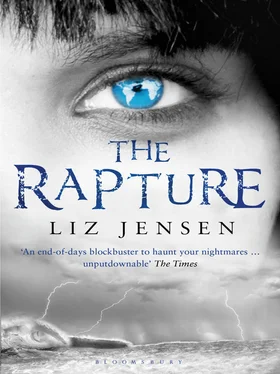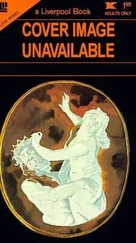‘Some bollocks about ethics. Regretting it?’ Frazer Melville checks his watch. ‘Two o’clock. Let’s catch the news. The story should be out.’
I flick on the BBC to a blare of theme music announcing the bulletin. When the dashboard screen fills with an aerial shot of Buried Hope, Frazer Melville thumps the steering wheel in delight. Scientists warn of a disaster in the North Sea set to strike Europe . The image switches to the press conference, where Harish Modak, Ned Rappaport and Kristin Jons dottir sit on a raised stage in a vast hall packed with journalists. They’re claiming it’s a global crisis on a scale… Now that the news is out, relief pulses through me, as welcome and sweet as a dose of morphine. Bethany, apparently indifferent, continues her off-tune singing. I turn up the volume to concentrate. In the past hour, leading environmentalist Harish Modak has warned of a tsunami in the North Sea which could devastate northern Europe and submerge much of Britain. He says the event has already been triggered by an accident at the North Sea methane rig, Buried Hope Alpha. ‘ Would you be free-hee from your passion and pride?’ warbles Bethany. ‘There’s power in the blood, power in the blood. Come for a clea-hensing to Calvary’s tide, there’s wonderful power in the blood!’ Professor Modak, whose team claimed responsibility for the Greenland graffiti that first drew attention to the Traxorac site, says a series of massive sub-sea avalanches… Bethany stops singing abruptly and announces, ‘My head hurts.’ On the TV, another view of Buried Hope Alpha appears, the arm of the yellow haulage crane cocked at a 4s-degree angle. While the North Sea Alliance has strongly refuted the professor’s claims, unusual marine activity has prompted speculation… An animated map shows the North Sea alive with arrows charting the mass movements of marine life. Harish Modak, Kristin and Ned reappear in front of a map of the ocean floor, and what I assume to be the seismic logs of the site. Our friends from the Norfolk farmhouse have cleaned up well. Clad in a suit, Ned is barely recognisable. He has shaved the stubble from his jaw and his wavy curls are gone, replaced by a sober, corporate-lawyer crop. Kristin, her hair in an elegant chignon, is wearing a dark green jacket and cream shirt, while Harish Modak looks sharp, alert and less frail than in the flesh. If Kristin is feeling nervous, she shows no sign of it as she explains the science, illustrated by figures, maps and graphs. She makes a clear, succinct case. Frazer Melville flexes his hands on the steering wheel, re-energised. Ned is next. He, too, has prepared efficiently.
‘In practical terms this means that if you live within ten kilometres of any coast, leave now. Pack food and medical supplies and move to high ground,’ he finishes. ‘Expect a domino effect.’
If the British public is anything like I was, the warning won’t sink in at first, I reflect. They’ll go into denial, or worry about peripherals like toothpaste and dog food. When Harish speaks, it’s with the regretful air of someone forced to disappoint a child. ‘Sudden global warming — with an increase of average global temperatures by four degrees or more — will be the most devastating result of the oncoming catastrophe. It has happened twice before on Earth in the distant past. Now we have every reason to believe it is happening again. We fear it will begin in this part of the world within a matter of hours.’
I think of my father in the nursing home. How fast do chalk cliffs crumble when submerged by a wall of water travelling at the speed of a jumbo jet? How long does it take for an old man’s lungs to fill with liquid?
Harish Modak is speaking again, this time over a wash of agitated voices.
‘Many won’t believe us. And that is their choice. But my associates and I believe in the right to know. Now that people have been warned, they can decide for themselves what to do. And I wish them luck.’
The anchorwoman appears again over running images of the press conference, where reporters continue to bombard the panel with shouted questions. Traxorac has firmly refuted Professor Modak’s claims, denying there’s any unusual activity at Buried Hope Alpha. The government has dismissed the alert as wholly unfounded, insisting that the evidence is not credible, and the public should not panic. But while the Chief Scientist has yet to make a public statement, leading figures in the scientific community — among them Kaspar Blatt, Akira Kamochi, Walid Habibi and Vance Oxek, who have all seen the Traxorac data — are supporting mass evacuation. They say the unusual behaviour of marine life, particularly off the Norwegian coast, is further confirmation that an instability on the sea floor could soon become critical . On the back seat, exhausted by her hymn-induced headache, Bethany is staring blankly out of the window. Ahead of us sprawls the cluttered, uneven skyline of London’s periphery. A second later, her eyelids droop.
On the satellite picture we looked at back at the farmhouse, the geography of south-eastern Britain — the hump of Norfolk and Suffolk, the grey-brown dotting of urban conurbations, the chiselled roads, the snaking gut of the Thames — seemed dream-like, its obliteration a hypothetical scenario you might idly fabricate on a screen if you had the software and the destructive urge. But here at ground level, with the sun’s glint giving the air the translucency of a troubled onion glaze, amid the rearing high-rises and paint-flaking retail outlets and towering cranes, the pornography of disaster springs all too readily into vivid technicolour: the flagellated trees, the crying children, the splintered road-signs, the human bodies, bobbing like swollen tubers. Once upon a time, I think, kings would plant oak forests for wood which could be felled in a hundred years to make ships to attack their enemies. They knew they would never live to see the resulting armadas but it wasn’t about seeing: it was about vision. What has happened to us? How is it that we, the inventors of devices that fly across oceans, hurtle to other planets, burrow underground, and kill from a distance; we, the atom-splitters, the antibiotic-discoverers, the computer-modellers, the artificial-heart-implanters, the creators of GM crops and ski-slopes in duhai, have failed to see five minutes beyond our own lifetimes?
The storm has rinsed the air but there’s still a cloying smell of decay. Has a whiff of rotten eggs crept into the organic reek, or has my imagination been hijacked?
‘In case of the Rapture, this vehicle may be unmanned,’ says Frazer Melville, pointing to the bumper sticker on the car ahead of us. To our left, the Thames has darkened to black, its surface flecked by quills of white foam. He looks pensive. ‘Turn to the God Channel.’ I fling a blanket across Bethany and zap until I hit The Worship Workshop, a studio discussion in which it’s clear from the aggressive way the guests are eyeing each other that a ferocious argument has erupted in response to the news. A thickset man in a well-cut suit is speaking animatedly, waving a Bible at his neighbour, a rangy preacher with sunburnt features and a great outdoors look.
‘The answer is in this book! It’s called the Holy Bible and it’s all in here! So with respect, to refute your argument, Marlon, and I appreciate your sincerity and don’t doubt your love of Jesus, I say this is a time for Bible study, and for a careful reading of the word of the Lord as it is laid down here. Let’s not go making inter- pretations on the hoof, in response to all this! Let’s stick to the basics. Let’s not get swept up in this is-it-or-isn’t-it until we have studied exactly what the scriptures say! And that’s going to take time—’
Читать дальше












